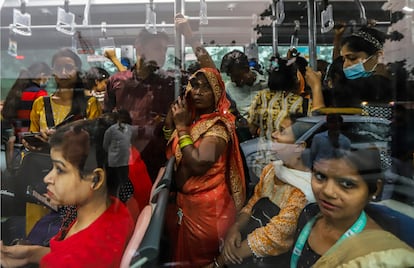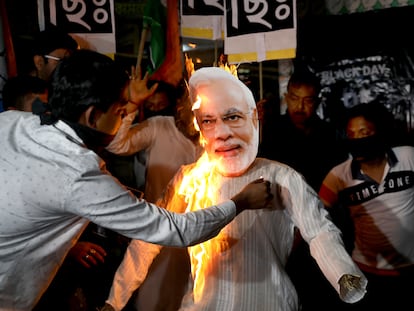India: The most populous nation is fighting for a place in the world
Amid an economic boom, the planet’s largest democracy faces huge social challenges and an eroding political pluralism

The noisy spats between the United States and China have drowned out a third voice that has so far been content to bide its time. Somewhere on the Indian subcontinent, a baby will soon be born who will push the population of this sprawling nation to 1,425,775,850 inhabitants. The United Nations estimates that India will reach this number on April 14 and become the world’s most populous nation ahead of China. Others think India has already sprinted past this mark. The symbolic milestone points to a profound change ahead for the South Asian nation, and a new 21st-century narrative for a booming global power jockeying for position in the world.
The time is ripe for India to offer a third way in a world wracked by strife and heading for a new Cold War. This year, the country will assume the rotating presidency of the G20 forum that brings together the world’s largest economies. The Indian government clearly aims to seize this opportunity to galvanize the nation and exert its influence internationally. Last year, when the former British colony surpassed the United Kingdom in gross domestic product (GDP) to become the world’s fifth largest economy, Prime Minister Narendra Modi said, “We have left behind those who ruled us for 250 years... We will not stop now.”
Expectations are high. In a year marked by pessimism and faltering economies, “India remains a bright spot,” said Pierre-Olivier Gourinchas when presenting the International Monetary Fund’s (IMF) economic outlook for 2023. India and China are expected to contribute 50% of the world’s growth this year. Giant corporations like Apple are moving production capacity to the country, and the State Bank of India believes the country will become the world’s third largest economy by 2029. Some are even more upbeat. “Many have said this is India’s decade. I truly believe it’s India’s century,” said McKinsey & Co’s CEO Bob Sternfels in a recent interview. Sternfels projects India will become a leading manufacturing hub because it will have 20% of the plant’s workers by 2047.
Many Indian analysts believe that the time has indeed come for a great leap forward. “China is facing a demographic crisis, while India is reaping a demographic dividend,” said Brahma Chellaney, professor of strategic studies at the New Delhi-based Center for Policy Research, one of the country’s leading think tanks. Chellaney cites the median age of 28, making India one of the youngest countries in the world. This population “is driving rapid economic growth, contributing to the consumption boom and driving innovation in our world-class information economy,” said Chellaney.
India has been steadily rising for decades. Bestselling historian Peter Frankopan wrote about it in The Silk Roads: A New History of the World (2015), a book that tries to make sense of the complex networks that make up the world’s central nervous system. Frankopan credits the spectacular 30-year expansion of the Indian middle class that continues today at an extraordinary pace. While some economists note the highly inequitable distribution of wealth in India and say the rich have benefited disproportionately, no one can dispute that households with more than $10,000 in annual disposable income have risen from two million in 1990 to 50 million in 2014.
Frankopan’s data is now over eight years old, but more recent numbers tell the same story. According to the World Bank, consumer spending in India more than doubled to $2.25 trillion since 2010. “This is only the beginning of a radical transformation, both in size and significance,” wrote Frankopan.
There is another dimension to India besides the booming economy. “Despite its vast cultural and ethnic diversity, India is the first developing economy that, from the outset, strove to modernize and prosper through a democratic system.” The challenge, writes Frankopan, is to take full advantage of relatively low labor costs and growing Western interest in shifting production from China so that India can become a manufacturing powerhouse.
Western corporations started looking more closely at India during the pandemic lethargy caused by Beijing’s zero-Covid strategy, which virtually closed its borders for three years. Friction between the U.S. and China and anxiety about conflict over Taiwan have burnished India’s lustre. “Companies are not abandoning the Asian giant, but they are indeed diversifying,” said Bettina Schoen-Behanzin, vice-president of the European Union Chamber of Commerce in China. “Investment once destined for China is going to other places, like North America, India and Southeast Asia.”
A key player for the U.S.
The door that has opened for India is also geopolitical. The country is trying to position itself “as a bridge between rival powers,” said Chellaney. The Indian government has skillfully steered the country through several recent geopolitical storms. It sealed a historic alliance with Russia, the country’s principal arms supplier. India never condemned the invasion of Ukraine and Russia is its primary source of oil. It’s also a member of the Shanghai Cooperation Organization, a Eurasian political, economic, international security and defense organization that includes Russia, China and Pakistan. India has signaled a willingness to look beyond its long-running border dispute with China and history of hostility with Pakistan.
Meanwhile, it has strengthened ties with the West and is part of the Quadrilateral Security Dialogue (the Quad), a strategic security dialogue between Australia, India, Japan and the United States. For the United States, India is a nuclear power that has become an increasingly important counterbalance to China’s growing power in the region.
The country’s lynchpin position may be unique in a “geopolitically fluid world,” said Harsh V. Pant, a foreign policy expert at the Observer Research Foundation, a New Delhi-based think tank. “India is trying to project itself as a country that can play a special role.”
Indian Foreign Minister Subrahmanyam Jaishankar says his country no longer has to abide by the rules of the past. “We have been conditioned to think of the post-1945 world as the norm, and to view any departure from this as a deviation,” wrote Jaishankar in The India Way: Strategies for an Uncertain World (2020). “In fact, our own complex, pluralist history underscores that the natural state of the world is multipolarity.”
The Jaishankar doctrine has a lot to do with the young demographics and national pride that the populist Modi has promoted since he was elected. “An aspirational India will inevitably give higher priority to achieving national goals and establishing a global presence,” wrote Jaishankar. Global dynamics are changing and so are Indian capabilities and ambitions. The opportunity cannot be missed, he says. “Our ability to address domestic challenges will determine India’s place in the world. At least we are focused on the right issues now: digitization, industrialization, urbanization, rural growth, infrastructure and skills.”
Harsh Pant believes India must be fully engaged in a contested geopolitical theater with the Indo-Pacific on center stage. “I think Indian policymakers recognize that this is a moment they can’t miss — they must respond,” said Pant. He points to the ambitious foreign trade policy launched in early April that set a target of $2 trillion in exports by 2030, almost triple the current figure.
Some skeptics say big announcements like the new export goal are overly exuberant and ultimately do the country a disservice. “The reality on the ground is different,” said Sushant Singh, another analyst at the Center for Policy Research. Singh served as a military officer for two decades before becoming a journalist and deputy editor of The Indian Express. He says India is still a very poor and unequal country with the lowest per capita income of the G20 countries (around $2,250, below countries like Bangladesh or Ghana). The IMF estimates India’s GDP at $3.5 trillion dollars, compared with $18.3 trillion dollars for China and $25 trillion for the United States.
Singh also says the country’s workforce is not well-enough educated to fulfill many of the forecasts. According to the Organization for Economic Cooperation and Development (OECD), 46% of Indians over 25 have not finished primary school. He also cites a Financial Times report about Apple’s difficulty in sourcing components from India that meet its quality standards. It is also still a predominantly agricultural country. Agriculture represents 20% of the economy but employs 45.5% of the workforce. According to government data, India exported less than 2% of the world’s merchandise exports. Singh says direct foreign investment fell by 15% between April and December 2022, and low unemployment figures camouflage a vast informal economy. Lastly, India has one of the world’s lowest rates of women with formal employment.
There has been progress, to be sure. According to the U.N., a record 415 million Indians emerged from “multidimensional poverty” in the last 15 years. But there is still a long way to go — five out of six people living in poverty belong to the lowest tribes and castes in Indian society. According to Oxfam, 10% of the population owns 77% of the wealth.
“Can India become a bigger economy?” asks Singh. “Sure. But not right away.” He believes the country will have trouble exploiting the impending “demographic dividend” that enabled China to benefit for decades. The same U.N. population report that forecasted India’s top-ranked population explains this demographic dividend as the opportunity to speed up economic growth and social development by increasing the proportion of the working age population. Currently, 40% of the Indian population is under 25, and globally, one in five people under 25 is Indian, according to U.N. estimates cited by the Pew Research Center. India’s median age of 28 contrasts with 38 in the United States and 39 in China, the other two most populous countries, which also have higher aging rates. In India, people over 65 represent 7% of the population, versus 14% in China and 18% in the United States. This figure will remain below 20% in India until 2063 and will not reach 30% until 2100. India’s fertility rate has been falling steadily (from 5.9 births per woman in 1950 to two today) and is expected to continue on a downward trend.

That is the demographic dividend — the phase when dependency ratios decline, making more resources available to invest in education, health, employment, social security and pensions, fostering economic growth and well-being in the short and medium term. But for that to happen, says the World Population Prospects report, countries must invest in developing human capital by ensuring access to health care and quality education at all ages and by promoting opportunities for productive employment and decent work.
An intolerant authoritarian drift
Singh thinks India may face what he calls a demographic disaster, and points to other serious problems like the intolerant authoritarian drift that began in 2014 when Modi took office. Modi’s Bharatiya Janata Party adheres to a Hindu nationalist ideology that has been denounced for its intolerance towards other religions and minorities and an excessive concentration of power. In January, the Indian government invoked emergency laws to block a BBC documentary on Modi’s role in the 2002 riots that killed 1,000 mostly Muslim residents of Gujarat when he was chief minister of that state.
Sweden’s V-Dem Institute (Varieties of Democracy) issued a report on the health of democracy around the world that describes India as an “electoral autocracy” and a country in which democracy has eroded over the last 10 years. Singh notes increasing pressure on some freedoms, like the right to information. Reporters Without Borders ranks the country 150th in press freedom, between Turkey and Sudan. One message is clear, says Singh — no one will celebrate the newborn who will make India the most populous country on earth. “The country is not proud of its population.”
Things are quite different in China, which in January announced its first population decline in 60 years, caused by a historic drop in the birth rate and a rapidly aging society. China estimates that its population dropped by 850,000 in 2022 to 1.4 billion people. Demographers believe this trend has major implications for the Asian giant’s economic growth, which is also slowing down.
China’s population decline is largely the result of its one-child policy (1980-2015) aimed at curbing its population boom. In 2021, the government began allowing married couples to have up to three children, and offered incentives to slow the declining birth rate. But the pandemic and changing lifestyles resulting from its own success have stymied the government’s efforts. By 2050, China’s population will fall by nearly 100 million, according to U.N. projections cited by the Pew Research Center. By 2100, the country’s population will be under 800 million.
“China will face the same [economic growth] problem as EU countries,” said Yi Fuxian, a medical researcher at the University of Wisconsin-Madison (USA) and author of Big Country With an Empty Nest (2007). Yi’s critical look at China’s family planning policy says the country will experience rising pension and health care costs, and a less dynamic productive sector. “The workforce is the backbone of the economy,” writes Yi, who believes that China’s decline will most likely propel India to the fore as the world’s leading economy, forcing a reshuffling of the international relations card deck.
Poonam Mutreja, a social development expert and executive director of the Population Foundation of India, says that demographers and economists “have always assumed or wanted to believe” that India’s huge young population will enable the country to enjoy a demographic advantage. “But we have all come to realize, and I think the Indian government has too, that the demographic dividend is not automatic,” she said. You must invest in young people, in their education and health, in developing their skills. “Employability requires skills — that is the challenge India will face.”
Mutreja thinks India could establish partnerships with other countries in need of skilled labor, as it did with Japan. India has earned a reputation for supplying talented workers to the world. Several CEOs of major corporations (Microsoft, Google, IBM and, until recently, Twitter and Mastercard) are of Indian origin. But Mutreja warns of a brain drain and thinks an interesting solution would be for other countries to invest in training Indian workers who would stay in the country.
Mutreja acknowledges that there is much work to be done, especially regarding sex education, reproductive planning, gender equality and incorporating women into the workforce in a “patriarchal” society. But she is optimistic about the years ahead and confident that we will see more Indians all over the world. The country will gradually become a manufacturing center because the government is working hard on developing the infrastructure for the potentially “huge” market and expanding middle class. And its G20 leadership, says Mutreja, is an excellent opportunity to showcase the government’s “brilliant diplomacy.”
Sign up for our weekly newsletter to get more English-language news coverage from EL PAÍS USA Edition









































